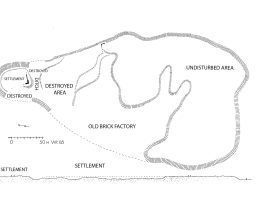Name
Balekin/Barlekin بالکین
Ali Mousavi, February 10th, 2023
Location: Tepe Balekin is located 5 km south of Malārd, central northern Iran, Tehran Province.
35°37’09.8″N 50°57’26.3″E
Map
Historical Period
Iron Age, Islamic
History and description
Tepe Balkin, which Burton Brown has recorded as Barlekin, is a sizable archaeological site dominated by a mound (400 x 210 m) with a height of 15 m above the surrounding plain. The site lies at 400 meters to the south of the present-day village of Mehrchin in the plain of Shahryar (fig. 1).
The site consists of a settlement area and a citadel in mud-brick (fig. 2). The fort is separated from the settlement area by a 15 m wide ditch and is approximately 60 by 50 m in size. The citadel is separated from the settlement area by a 15 m wide ditch and is about 60 by 50 m in size. An unmortared bastion corner made of large rubble stones and traces of walls on the eastern slope of the settlement area is still visible at the site. The settlement was probably fortified. The site has suffered from the presence of a brick factory that destroyed more than half of the settlement area and part of the citadel. Based on the pottery evidence, the site was first occupied in the second millennium B.C. The construction of the citadel and walled settlement seems to be of a later date, possibly the Islamic period.
According to T. Burton-Brown, the excavator of Balekin, “eight levels of deposit were distinguished at the site”: the top being noted as Level I and the lowest as Level VIII, To some considerable extent the lowest Level (VIII) produced ceramics comparable with material typical of Stratum K at Geoy Tepe in Azarbaijan…” It seems that no architectural feature or structure has been observed or uncovered. The stratigraphy is based on ceramic types.
Archaeological Exploration
Theodore Burton-Brown briefly excavated at Tepe Balekin, a site he recorded as Barlekin, in 1957. He writes that the excavation of the site “was carried out in a single shaft some twenty feet deep. Little was found except pottery fragments.” In 1996, Wolfram Kleiss surveyed the site on behalf of the German Archaeological Institute.
Finds
Finds consist mostly of ceramic finds, typical late second millennium / early first millennium B.C. gray ware. Mud-brick structures are visible in different areas of the site, in particular where walls have been cut and partially destroyed by farming and industrial activities.
Bibliography
Burton-Brown, T., Excavations at Barlekin, Wootton Woodstock, Oxfordshire, 1981.
Kleiss, W., “Fundorte des 2. und 1. Jahrtausends v. Chr. Mit grauer Ware in Iran,” Archaeologisches Mitteilungen aus Iran, vol. 29, 1997, pp. 3-5 (for Balkin Tepe).




 DOWNLOAD AS PDF
DOWNLOAD AS PDF

















































































































